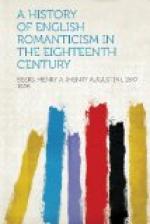[15] James Beattie, “Dissertation on Fable and Romance.” “Argenius,” was printed in 1621.
[16] “The Dictionary of National Biography” miscalls it “Earl of Canterbury,” and attributes it, though with a query, to John Leland.
[17] See also, for a notice of this writer, Julia Kavanagh’s “English Women of Letters.”
[18] Maturin’s “Melmoth the Wanderer” (1820) had some influence on the French romantic school and was utilized, in some particulars, by Balzac.
[19] Following is a list of Mrs. Radcliffe’s romances: “The Castles of Athlin and Dunbayne” (1789); “Sicilian Romance” (1790); “Romance of the Forest” (1791); “Mysteries of Udolpho” (1794); “The Italian” (1797); “Gaston de Blondville” (1826). Collections of her poems were published in 1816, 1834, and 1845.
[20] See “Childe Harold,” canto iv, xviii.
[21] “Roundabout Papers,” “A Peal of Bells.” “Monk” Lewis wrote at sixteen a burlesque novel, “Effusions of Sensibility,” which remained in MS.
[22] “O Radcliffe, thou once wert the charmer
Of girls who sat
reading all night:
They heroes were striplings
in armor,
Thy heroines,
damsels in white.”
—Songs,
Ballads and Other Poems.
By Thos. Haynes Bayly, London, 1857, p. 141.
“A novel now is nothing more
Than an old castle and a creaking door,
A distant hovel,
Clanking of chains, a gallery, a light,
Old armor and a phantom all in white,
And there’s a novel.”
—George Colman, “The
Will."
[23] Several of her romances were dramatized and translated into French. It is curious, by the way, to find that Goethe was not unaware of Walpole’s story. See his quatrain “Die Burg von Otranto,” first printed in 1837.
“Sind die Zimmer saemmtlich besetzt der Burg von Otranto:
Kommt, voll innigen Grimmes, der erste Riesenbesitzer
Stuckweis an, and verdraengt die neuen falschen Bewohner.
Wehe! den Fliehenden, weh! den Bleibenden also geschiet es.”
[24] Ossian.
[25] See her “Journey through Holland,” etc. (1795)
[26] cf. Keats, “The Eve of Saint Agnes”:
“The arras rich with
hunt and horse and hound
Flattered in the besieging
wind’s uproar,
And the long carpets rose
along the gusty floor.”
[27] “Castles of Athlin and Dunbayne.”
[28] See Julia Kavanagh’s “English Women of Letters.”
CHAPTER VIII.
Percy and the Ballads.




